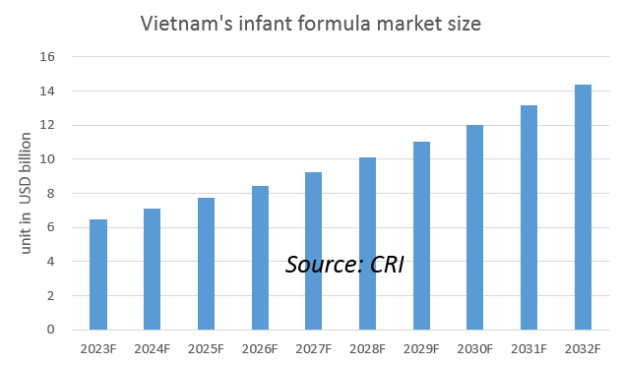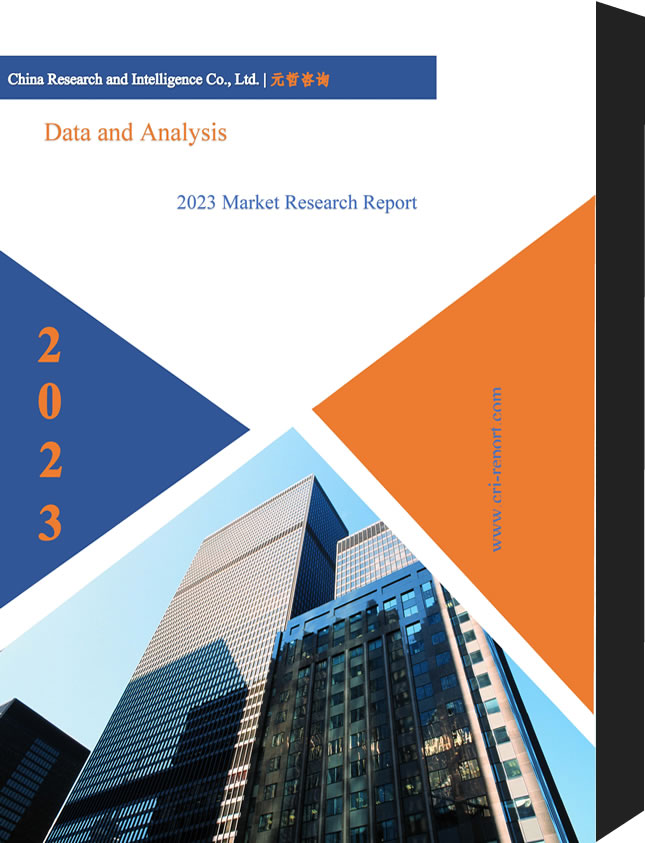Description
Southeast Asia Infant Formula Industry Overview
With the rapid economic development and urbanization in Southeast Asia, a large number of women of childbearing age have entered the workplace, making it difficult for them to breastfeed and turn to infant formula. At the same time, the per capita income in Southeast Asia is growing, the standard of living of residents is improving, and young parents are spending more on infant formula and other maternal and infant areas, further promoting the development of the infant formula industry.
Southeast Asia’s 10 countries have a large population base and a relatively young demographic structure, and the large infant and toddler population makes Southeast Asia’s demand for infant formula grow. Take Vietnam as an example, in 2022, Vietnam has a population of about 98 million people, with a population of about 7.5 million people aged 0-4 years old and a birth rate of 1.47%, the infant formula industry has great potential for development, attracting brands such as Meiji, Abbott and Viagra to the Vietnamese market.

Southeast Asia in this report includes 10 countries: Singapore, Thailand, Philippines, Malaysia, Indonesia, Vietnam, Myanmar, Brunei, Laos and Cambodia. With a total population of over 600 million by the end of 2021, Southeast Asia has an overall economic growth rate higher than the global average and is one of the key drivers of future global economic growth.
According to CRI’s analysis, the economic levels of the 10 Southeast Asian countries vary greatly, with Singapore being the only developed country with a per capita GDP of about US$73,000 in 2021. While Myanmar and Cambodia will have a GDP per capita of less than US$2,000 in 2021. The population and minimum wage levels of each country also vary greatly. Brunei, which has the smallest population, will have a total population of less than 500,000 people in 2021, while Indonesia, which has the largest population, will have a population of about 275 million people in 2021.
CRI expects the infant formula industry in Southeast Asia to maintain growth from 2023-2032.
Topics covered:
- Southeast Asia Infant Formula Industry Status and Major Sources in 2018-2022
- What is the Impact of COVID-19 on Southeast Asia Infant Formula Industry?
- Which Companies are the Major Players in Southeast Asia Infant Formula Industry Market and What are their Competitive Benchmarks?
- Key Drivers and Market Opportunities in Southeast Asia Infant Formula Industry
- What are the Key Drivers, Challenges, and Opportunities for Southeast Asia Infant Formula Industry during 2023-2032?
- What is the Expected Revenue of Southeast Asia Infant Formula Industry during 2023-2032?
- What are the Strategies Adopted by the Key Players in the Market to Increase Their Market Share in the Industry?
- What are the Competitive Advantages of the Major Players in Southeast Asia Infant Formula Industry Market?
- Which Segment of Southeast Asia Infant Formula Industry is Expected to Dominate the Market in 2032?
- What are the Major Adverse Factors Facing Southeast Asia Infant Formula Industry?
Table of Contents
1 Singapore Infant Formula Industry Analysis
1.1 Singapore Infant Formula Industry Development Environment
1.1.1 Geography
1.1.2 Population
1.1.3 Economy
1.1.4 Minimum Wage in Singapore
1.2 Singapore Infant Formula Industry Operation Status 2018-2022
1.2.1 Production Status
1.2.2 Sales Status
1.2.3 Import and Export Status
1.3 Singapore Major Infant Formula Production and Sales Companies Analysis
2 Analysis of Thailand’s Infant Formula Industry
2.1 Development Environment of Thailand Infant Formula Industry
2.1.1 Geography
2.1.2 Population
2.1.3 Economy
2.1.4 Thailand Minimum Wage
2.2 Thailand Infant Formula Industry Operation Status 2018-2022
2.2.1 Production Status
2.2.2 Sales Status
2.2.3 Import and Export Status
2.3 Analysis of Major Infant Formula Production and Sales Companies in Thailand
3 Analysis of Infant Formula Industry in the Philippines
3.1 Development Environment of Infant Formula Industry in the Philippines
3.1.1 Geography
3.1.2 Population
3.1.3 Economy
3.1.4 Minimum Wage in the Philippines
3.2 Philippines Infant Formula Industry Operation Status 2018-2022
3.2.1 Production Status
3.2.2 Sales Status
3.2.3 Import and Export Status
3.3 Analysis of Major Infant Formula Production and Sales Companies in the Philippines
4 Malaysia Infant Formula Industry Analysis
4.1 Malaysia Infant Formula Industry Development Environment
4.1.1 Geography
4.1.2 Population
4.1.3 Economy
4.1.4 Minimum Wage in Malaysia
4.2 Malaysia Infant Formula Industry Operation Status 2018-2022
4.2.1 Production Status
4.2.2 Sales Status
4.2.3 Import and Export Status
4.3 Malaysia Major Infant Formula Production and Sales Companies Analysis
5 Indonesia Infant Formula Industry Analysis
5.1 Indonesia Infant Formula Industry Development Environment
5.1.1 Geography
5.1.2 Population
5.1.3 Economy
5.1.4 Indonesia Minimum Wage
5.2 Indonesia Infant Formula Industry Operation Status 2018-2022
5.2.1 Production Status
5.2.2 Sales Status
5.2.3 Import and Export Status
5.3 Indonesia Major Infant Formula Production and Sales Companies Analysis
6 Analysis of Vietnam Infant Formula Industry
6.1 Development Environment of Vietnam Infant Formula Industry
6.1.1 Geography
6.1.2 Population
6.1.3 Economy
6.1.4 Minimum Wage in Vietnam
6.2 Vietnam Infant Formula Industry Operation Status 2018-2022
6.2.1 Production Status
6.2.2 Sales Status
6.2.3 Import and Export Status
6.3 Analysis of Major Infant Formula Production and Sales Enterprises in Vietnam
7 Analysis of Myanmar’s Infant Formula Industry
7.1 Development Environment of Myanmar Infant Formula Industry
7.1.1 Geography
7.1.2 Population
7.1.3 Economy
7.1.4 Myanmar Minimum Wage
7.2 Myanmar Infant Formula Industry Operation Status 2018-2022
7.2.1 Production Status
7.2.2 Sales Status
7.2.3 Import and Export Situation
7.3 Myanmar Major Infant Formula Production and Sales Companies Analysis
8 Analysis of Brunei’s Infant Formula Industry
8.1 Brunei Infant Formula Industry Development Environment
8.1.1 Geography
8.1.2 Population
8.1.3 Economy
8.1.4 Brunei Minimum Wage
8.2 Brunei Infant Formula Industry Operation Status 2018-2022
8.2.1 Production Status
8.2.2 Sales Status
8.2.3 Import and Export Status
8.3 Brunei Major Infant Formula Production and Sales Companies Analysis
9 Laos Infant Formula Industry Analysis
9.1 Development Environment of Infant Formula Industry in Laos
9.1.1 Geography
9.1.2 Population
9.1.3 Economy
9.1.4 Minimum Wage in Laos
9.2 Laos Infant Formula Industry Operation Status 2018-2022
9.2.1 Production Status
9.2.2 Sales Status
9.2.3 Import and Export Status
9.3 Laos Major Infant Formula Production and Sales Enterprises Analysis
10 Analysis of Cambodia’s Infant Formula Industry
10.1 Development Environment of Cambodia Infant Formula Industry
10.1.1 Geography
10.1.2 Population
10.1.3 Economy
10.1.4 Minimum Wage in Cambodia
10.2 Cambodia Infant Formula Industry Operation Status 2018-2022
10.2.1 Production Status
10.2.2 Sales Status
10.2.3 Import and Export Situation
10.3 Major Infant Formula Production and Sales Companies in Cambodia Analysis
11 Southeast Asia Infant Formula Industry Outlook 2023-2032
11.1 Southeast Asia Infant Formula Industry Development Influencing Factors Analysis
11.1.1 Favorable Factors
11.1.2 Unfavorable Factors
11.2 Southeast Asia Infant Formula Industry Revenue Forecast 2023-2032
11.3 Southeast Asia Infant Formula Industry Sales Analysis 2023-2032
11.4 Impact of COVID-19 Outbreak on Infant Formula Industry



Reviews
There are no reviews yet.